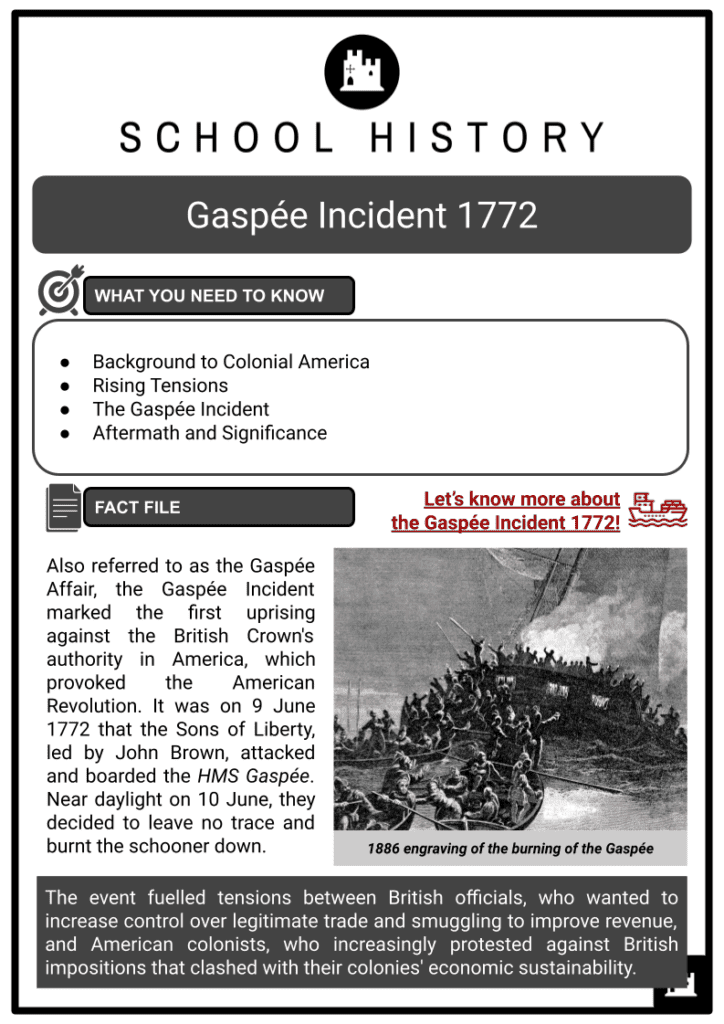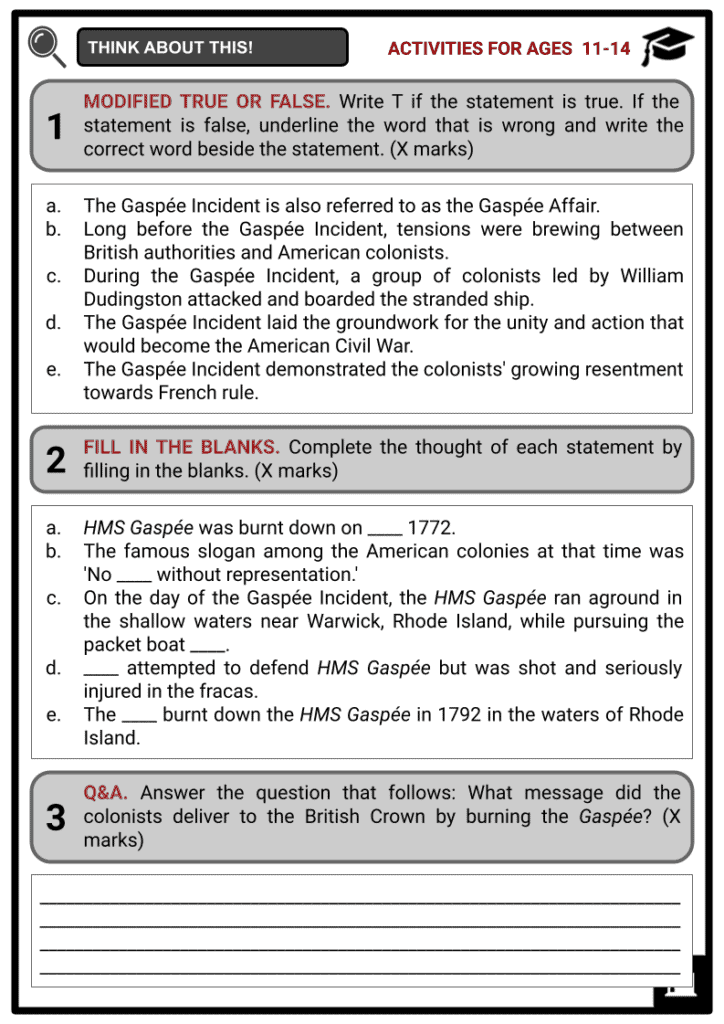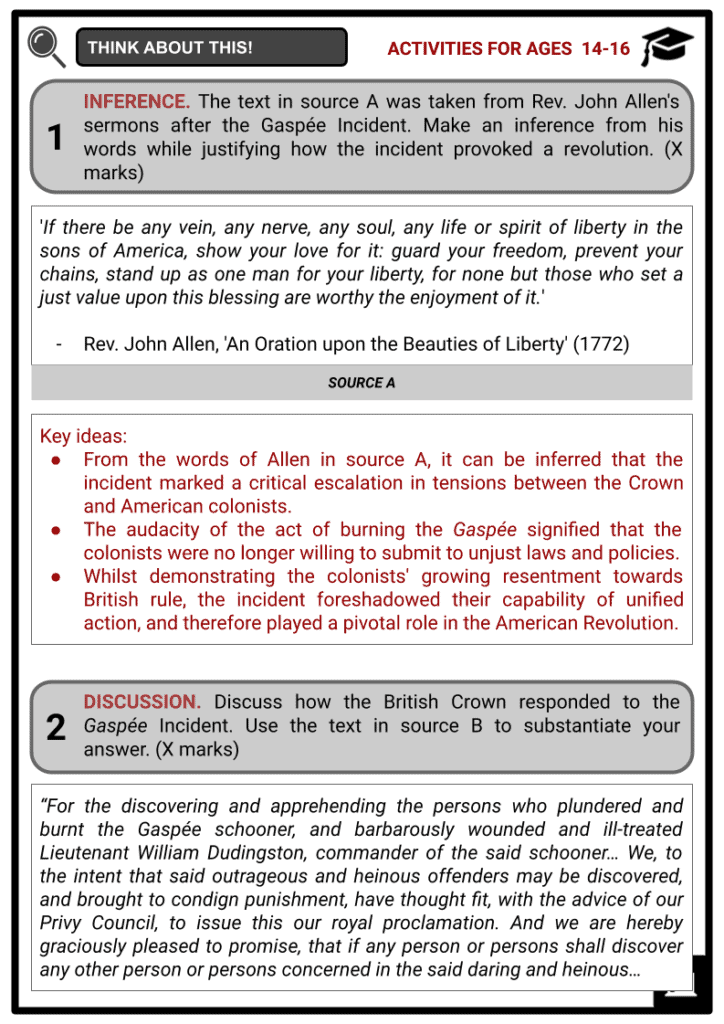Gaspée Incident 1772 Worksheets
Do you want to save dozens of hours in time? Get your evenings and weekends back? Be able to teach about the Gaspée Incident 1772 to your students?
Our worksheet bundle includes a fact file and printable worksheets and student activities. Perfect for both the classroom and homeschooling!
Summary
- Background to Colonial America
- Rising Tensions
- The Gaspée Incident
- Aftermath and Significance
Key Facts And Information
Let’s know more about the Gaspée Incident 1772!

Also referred to as the Gaspée Affair, the Gaspée Incident marked the first uprising against the British Crown's authority in America, which provoked the American Revolution. It was on 9 June 1772 that the Sons of Liberty, led by John Brown, attacked and boarded the HMS Gaspée. Near daylight on 10 June, they decided to leave no trace and burnt the schooner down. The event fuelled tensions between British officials, who wanted to increase control over legitimate trade and smuggling to improve revenue, and American colonists, who increasingly protested against British impositions that clashed with their colonies' economic sustainability.
Background to Colonial America
- Colonial America constitutes the English colonies along the Eastern seaboard. When the English began establishing colonies on the American continent, 13 colonies came together to form the United States. These colonies were: New Hampshire, Connecticut, Massachusetts, Rhode Island, New Jersey, New York, Delaware, Pennsylvania, Maryland, Virginia, North Carolina, South Carolina and Georgia.
- Long before the Gaspée Incident, tensions were brewing between British authorities and American colonists. The Seven Years' War fought by England and France had numerous effects on the economic, political, governmental and social relationship between the European powers and their colonies. Both France and Britain experienced financial crises because of the war, with long-term consequences.
- After the war, the British Crown sought sources of revenue to pay the national debt of Great Britain, which led to the implementation of new taxes, such as the Sugar Act of 1764, Stamp Act of 1765, Townshend Acts of 1767 and the Tea Act of 1773. These acts imposed without the colonists' consent set the stage for widespread resentment against British rule.
Rising Tensions
- As the British government increased its enforcement of these new tax laws, colonists' frustration escalated. The taxes were not only unjust, but they also significantly impacted the prosperity of many colonists, particularly those involved in trade.
- The colonies lacked representation in the British Parliament, a situation encapsulated in the famous slogan of the time, 'No taxation without representation.' To add to the mounting tension, the British government began to take more extreme measures to ensure compliance with the taxes, deploying more customs schooners like the HMS Gaspée to patrol the American coast.
- These schooners were seen by many as a physical embodiment of British tyranny, and their aggressive enforcement practices did little to endear them to colonists. The crews would regularly board and search colonial vessels, often under the slightest suspicion of smuggling or tax evasion. These inspections were invasive, disruptive, and often resulted in the seizure of goods. The resentment towards these British practices was growing, setting the stage for a significant clash between the colonists and British authorities in the form of the Gaspée Incident.
The Incident
- The Gaspée Incident was a significant event that paved the way for the American Revolution. The incident revolved around the British customs schooner, the HMS Gaspée, tasked with implementing the much-despised Navigation Acts in Rhode Island's waters.
- The Navigation Acts were British laws that heavily regulated trade between England and its colonies. The acts were initially designed to bolster British economic interests by ensuring England reaped the benefits of the lucrative colonial trade. However, these acts were widely resented in Rhode Island due to the colony's dependence on trade for their livelihood. The enforcement of these laws led to a significant restriction on Rhode Island's economic activities, as they were barred mainly from direct trade with other nations and could only export their goods using English ships.

Another depiction of the burning of the Gaspée - The HMS Gaspée, a British customs schooner, was commissioned in 1763 as part of the British effort to crack down on illegal trade and enforce the widely unpopular Navigation Acts in the American colonies. The ship's crew, under the command of Lt William Dudingston, gained a notorious reputation among local traders for their zealous and often aggressive enforcement of the laws. Their tactics, which included the boarding and seizing of colonial vessels without cause, significantly intensified colonial resentment towards British authorities.
- On 9 June 1772, the HMS Gaspée ran aground in the shallow waters near Warwick, Rhode Island, while pursuing the packet boat Hannah, which was a small, swift ship commonly used for short, scheduled deliveries of mail, passengers and goods such as food and merchandise. Seizing the opportunity, a group of colonists from the Sons of Liberty, led by John Brown and Abraham Whipple, attacked and boarded the stranded ship. Meeting little resistance from the surprised and outnumbered crew, the colonists swiftly gained control of the vessel.
- Lieutenant William Dudingston attempted to defend the ship but was shot and seriously injured in the fracas, prompting the already disoriented crew to surrender. The colonists held the crew captive, ensuring no messages could be sent to nearby British ships. With the crew under control, they looted the valuable commodities and official documents, giving insight into the British naval strategies. Near daylight on 10 June, the colonists decided to leave no trace of their audacious act and set the ship on fire. The HMS Gaspée was reduced to ashes, symbolising the American colonists’ burning desire for freedom.

John Brown
Aftermath and Significance
- British officials were outraged by the Gaspée Incident after it was reported to London. Rhode Island Governor Joseph Wanton offered a reward of 100 pounds to anyone who could provide information that would lead to the arrest of the culprits. Unfortunately, no one came forward with information because the investigation was leaked to the newspapers.
- In 1773, Governor Wanton provided a report to British officials in London regarding the incident, which did not satisfy King George III. So he appointed a Royal Commission to investigate the matter.
- On 5 January, the commissioners convened in Newport with Wanton, Hopkins, Chief Justice Frederick Smythe of New Jersey, and Commissioner Daniel Horsmanden of New York present. During the meeting, the commissioners questioned the British naval officers about their purpose for being in Narragansett Bay.
- On 12 January, Admiral Montagu urged the commissioners to find those responsible for the incident but they couldn't determine who was involved due to lack of evidence and some witnesses not attending. This resulted in the investigation being concluded on 23 June 1773. The final report addressed to the king confirmed that the Gaspée was destroyed by unidentified individuals and no arrests were made.
- The incident marked a critical escalation in tensions between the Crown and American colonists, and notably, it was one of the first unified acts of rebellion against British rule. In many ways, the Gaspée Incident laid the groundwork for the unity and action that would become the American Revolution.
- With the burning of the HMS Gaspée, a strong message was sent to the British Crown: the colonists were no longer willing to submit to unjust laws and policies. The audacity of the act and the unity displayed by the colonists in its execution emboldened further acts of resistance, sowing seeds of rebellion across the 13 colonies.
- The perpetrators remaining unidentified and unpunished despite the offered rewards was primarily due to the solidified unity and determination among the American colonists, who refused to betray one another to the British. The inability of the Crown to apprehend the perpetrators was a psychological victory for the colonists, boosting their morale and strengthening their resolve to fight for their rights.
- The Gaspée Incident also highlighted the extent of British desperation and the lengths they were willing to go to to maintain control over the American colonies. Their outrage and heavy-handed response fuelled the colonists' resentment and added to the growing grievances against the British Crown.
- In the grand scheme of the American Revolution, the Gaspée Incident was a pivotal moment that galvanised the American colonists and pushed them closer to fully fledged rebellion. It demonstrated the potential of unified action against common oppression. It set a precedent for future acts of resistance that eventually led to the Declaration of Independence and the Revolutionary War.
- While the Gaspée Incident may be less known than events like the Boston Tea Party, its significance in the American journey to independence should not be underestimated. It demonstrated the colonists' growing resentment towards British rule, foreshadowed their capability of unified action, and therefore played a pivotal role in the American Revolution.
Image Sources
- https://upload.wikimedia.org/wikipedia/commons/thumb/0/08/Destruction_of_the_schooner_gaspee.jpg/1920px-Destruction_of_the_schooner_gaspee.jpg
- https://upload.wikimedia.org/wikipedia/commons/thumb/d/de/P97_Burning_of_the_Gaspee_Schooner.jpg/1280px-P97_Burning_of_the_Gaspee_Schooner.jpg
- https://upload.wikimedia.org/wikipedia/commons/1/15/1846-47_John_Brown_by_Augustus_Washington_%28without_frame%29.jpg
Frequently Asked Questions
- What was the Gaspee Incident of 1772?
The Gaspee Incident occurred on 9 June 1772 in Rhode Island's Narragansett Bay when a British customs schooner named HMS Gaspee ran aground, leading to a confrontation with American colonists.
- What was the main significance of the Gaspee Incident?
The main significance of the Gaspee Incident was that it heightened tensions between American colonists and British authorities, as a catalyst for further acts of resistance and leading to the American Revolution. It showcased colonial discontent with British rule and enforcement of trade policies, contributing to the road to independence.
- Who led the attack on the Gaspee?
The attack on the Gaspee was led by a group of American colonists, including John Brown, a prominent merchant and a leader in the Sons of Liberty, a colonial protest organisation.






